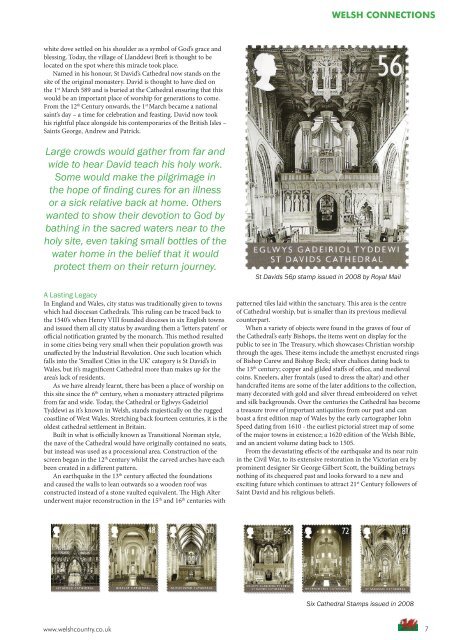Welsh Country March-April 2017
You also want an ePaper? Increase the reach of your titles
YUMPU automatically turns print PDFs into web optimized ePapers that Google loves.
WELSH CONNECTIONS<br />
white dove settled on his shoulder as a symbol of God’s grace and<br />
blessing. Today, the village of Llanddewi Brefi is thought to be<br />
located on the spot where this miracle took place.<br />
Named in his honour, St David’s Cathedral now stands on the<br />
site of the original monastery. David is thought to have died on<br />
the 1 st <strong>March</strong> 589 and is buried at the Cathedral ensuring that this<br />
would be an important place of worship for generations to come.<br />
From the 12 th Century onwards, the 1 st <strong>March</strong> became a national<br />
saint’s day – a time for celebration and feasting. David now took<br />
his rightful place alongside his contemporaries of the British Isles –<br />
Saints George, Andrew and Patrick.<br />
Large crowds would gather from far and<br />
wide to hear David teach his holy work.<br />
Some would make the pilgrimage in<br />
the hope of finding cures for an illness<br />
or a sick relative back at home. Others<br />
wanted to show their devotion to God by<br />
bathing in the sacred waters near to the<br />
holy site, even taking small bottles of the<br />
water home in the belief that it would<br />
protect them on their return journey.<br />
A Lasting Legacy<br />
In England and Wales, city status was traditionally given to towns<br />
which had diocesan Cathedrals. This ruling can be traced back to<br />
the 1540’s when Henry VIII founded dioceses in six English towns<br />
and issued them all city status by awarding them a ‘letters patent’ or<br />
official notification granted by the monarch. This method resulted<br />
in some cities being very small when their population growth was<br />
unaffected by the Industrial Revolution. One such location which<br />
falls into the ‘Smallest Cities in the UK’ category is St David’s in<br />
Wales, but it’s magnificent Cathedral more than makes up for the<br />
area’s lack of residents.<br />
As we have already learnt, there has been a place of worship on<br />
this site since the 6 th century, when a monastery attracted pilgrims<br />
from far and wide. Today, the Cathedral or Eglwys Gadeiriol<br />
Tyddewi as it’s known in <strong>Welsh</strong>, stands majestically on the rugged<br />
coastline of West Wales. Stretching back fourteen centuries, it is the<br />
oldest cathedral settlement in Britain.<br />
Built in what is officially known as Transitional Norman style,<br />
the nave of the Cathedral would have originally contained no seats,<br />
but instead was used as a processional area. Construction of the<br />
screen began in the 12 th century whilst the carved arches have each<br />
been created in a different pattern.<br />
An earthquake in the 13 th century affected the foundations<br />
and caused the walls to lean outwards so a wooden roof was<br />
constructed instead of a stone vaulted equivalent. The High Alter<br />
underwent major reconstruction in the 15 th and 16 th centuries with<br />
St Davids 56p stamp issued in 2008 by Royal Mail<br />
patterned tiles laid within the sanctuary. This area is the centre<br />
of Cathedral worship, but is smaller than its previous medieval<br />
counterpart.<br />
When a variety of objects were found in the graves of four of<br />
the Cathedral’s early Bishops, the items went on display for the<br />
public to see in The Treasury, which showcases Christian worship<br />
through the ages. These items include the amethyst encrusted rings<br />
of Bishop Carew and Bishop Beck; silver chalices dating back to<br />
the 13 th century; copper and gilded staffs of office, and medieval<br />
coins. Kneelers, alter frontals (used to dress the altar) and other<br />
handcrafted items are some of the later additions to the collection,<br />
many decorated with gold and silver thread embroidered on velvet<br />
and silk backgrounds. Over the centuries the Cathedral has become<br />
a treasure trove of important antiquities from our past and can<br />
boast a first edition map of Wales by the early cartographer John<br />
Speed dating from 1610 - the earliest pictorial street map of some<br />
of the major towns in existence; a 1620 edition of the <strong>Welsh</strong> Bible,<br />
and an ancient volume dating back to 1505.<br />
From the devastating effects of the earthquake and its near ruin<br />
in the Civil War, to its extensive restoration in the Victorian era by<br />
prominent designer Sir George Gilbert Scott, the building betrays<br />
nothing of its chequered past and looks forward to a new and<br />
exciting future which continues to attract 21 st Century followers of<br />
Saint David and his religious beliefs.<br />
Six Cathedral Stamps issued in 2008<br />
www.welshcountry.co.uk 7




